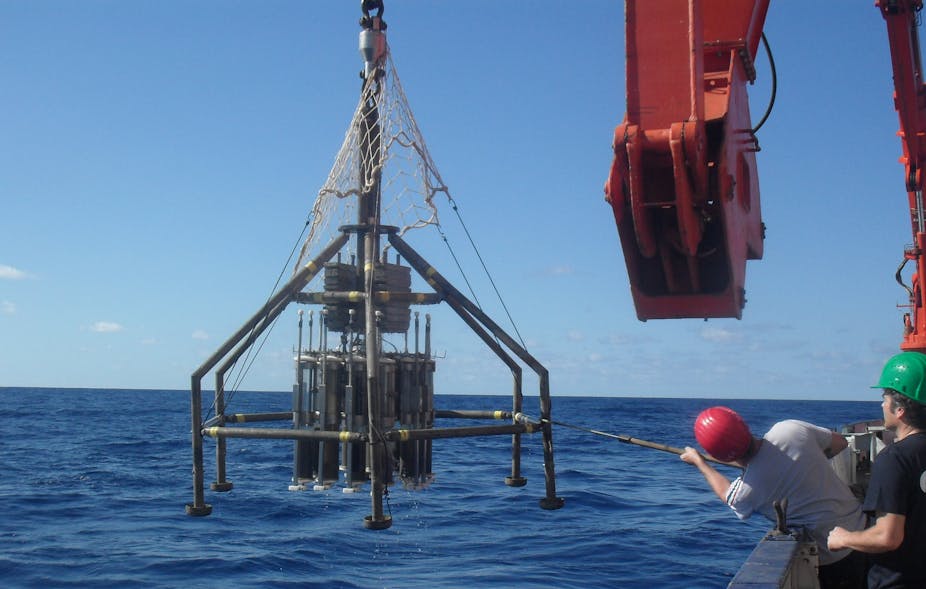Whether the water at your local beach is being roiled by nasty weather or is a perfectly calm expanse of blue, there’s always a great deal going on under the surface. The ocean is composed of various currents and water masses; those currents flow around the world through what is called thermohaline circulation.
This circulation drives the distribution of heat, salinity and nutrients throughout the world’s oceans, ensuring that our whole planet is habitable for life.
The Atlantic leg of this circulation is called the Atlantic Meridional Overturning Circulation (AMOC). The Atlantic Ocean is situated between the Americas, western Europe and the western margin of Africa. The AMOC distributes heat away from the tropics northward, ensuring that tropical regions are not overheated, which would cause an imbalance in climate. It, like other oceanographic systems, varies annually, over decades and centennially. Scientists study these oceanographic systems over a longer time period to understand how they work and to make predictions on how they will function in future and what their impact may be.
In July 2023 two Danish academics – physicist Peter Ditlevsen and his sister, the statistician Susanne Ditlevsen – published a paper in which they stated that the AMOC was in decline and would likely shut down mid-century. That would bring dramatic consequences: rising sea levels, global heating, shifts in marine ecosystems, and seriously compromised food security. It could also seriously affect the upwelling marine ecosystem along the western margin of South Africa and Namibia, which is the most productive upwelling system in the Atlantic.
In the Ditlevsens’ scenario, Europe could see massive cooling of around 5°C to 10°C and the tropics could become overheated. Certain areas around the world would experience severe droughts and flooding. And the oceans would become more acidic.
The paper has generated controversy in the scientific community. As a geologist whose research interests include oceanographic change, I don’t find the article surprising. Research has shown that the AMOC has not been a stable feature of the ocean over millions of years and is sensitive to climate change. However, I agree with the general scientific consensus: the shutdown of the AMOC will not be as abrupt as the paper claims; it will instead be more gradual over the coming centuries.
Constant shifts
The Atlantic Ocean is not the only part of the ocean’s thermohaline circulation that is experiencing shifts. In the South Indian Ocean, the Agulhas Current is also weakening due to changing distribution in heat and freshwater from the Pacific Ocean to the Indian Ocean.
And in the Pacific Ocean, west of the Americas, El Niño events – the warming of that specific ocean – are intensifying.
The Ditlevsens based their findings largely on sea surface temperatures. The paper does not consider other factors such as which carbon dioxide (CO₂) levels in the atmosphere (and take-up by the oceans), coupled with temperature changes, would be the tipping point for the AMOC to shut down, or the state of deep water generation – water of specific density, salinity and temperature – at the source regions in the North Atlantic for the functioning of the AMOC.
The broad consensus among scientists is that, while the AMOC is weakening, the probability of it completely shutting down in this century is low.
Read more: Atlantic collapse: Q&A with scientists behind controversial study predicting a colder Europe
It’s also important to point out that ocean currents and circulation change over time. The AMOC has strengthened and waned pre-human history over geological time, particularly in response to colder or warmer periods. For example, studies along the western margin of South Africa have found that the AMOC in the South Atlantic is sensitive to changes in the global climate cycle.

Previous research has also indicated that the AMOC weakened or shut down before, thousands of years ago during the Last Glacial Maximum. That happened under different conditions than what we are experiencing today. During that time the climate was much colder and the ice sheets were at a maximum position, although a warming phase led to the retreat of ice sheets afterwards.
Perspective
This large body of evidence suggests that the AMOC will continue to weaken as currents fluctuate over time, driven by different environmental factors. But scientists have not yet accepted that a total shutdown of the system will occur over the next few years or couple of decades.
However, the paper that’s caused so much controversy shouldn’t be dismissed entirely. For one thing, it’s a good conversation starter on this very important topic. It also provides a timeline for when the AMOC could shut down – anywhere between 2025 and 2095. While the consensus is that this isn’t accurate, it’s a useful starting point from which other scientists could generate scenarios and models for further study.
In doing so, our collective understanding of the AMOC system will deepen, which should influence policy decision-making.

